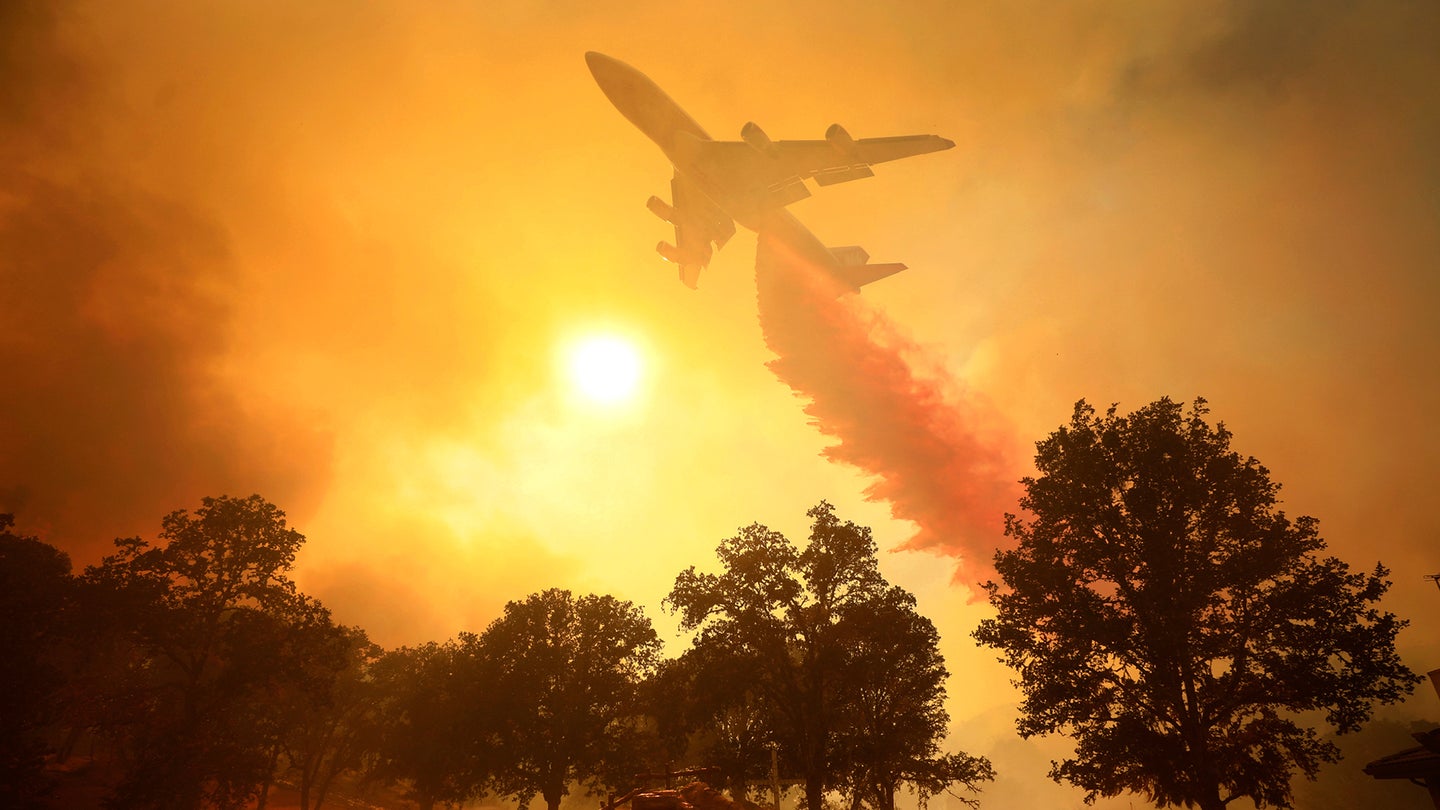Inside the Massive Firefighting Aircraft in California
Dousing the devastating wildfires from the sky involves a carefully choreographed ballet—above Hell…

Among all the horrifying images and videos emerging from the wildfires in California, there have been a few moments of inspiration: Fire crews working tirelessly to fight the blazes, communities pulling together in their darkest hours, animals domestic and wild being rescued. But some of the most startling footage has come from the aerial firefighters dropping loads of water or fire retardant with pinpoint precision.
The aircraft vary from helicopters scooping water out of lakes and pools to large twin-engine amphibious airplanes up to gigantic converted airliners and cargo jets, including DC-10s and, most amazingly, a Boeing 747-400 that roars into view low to the ground, deposits thousands of gallons of bright red retardant on the flames, then rockets out of sight again. It’s been a presence for several days north of San Francisco, where it’s been battling the Camp Fire in Butte County.
That aircraft in particular, the Global SuperTanker, has generated lots of buzz for its crew’s heroic feats of flying, given the airplane’s enormous size and the obvious challenge of depositing flame retardant precisely where it can do the most good. That technique is indeed as difficult as you’d guess, involving considerable coordination, preparation, and finesse at the controls, according to 30-year veteran firefighter Bill Gabbert, publisher of Wildfire Today.
Gabbert flew with the aircraft last year during a mission to fight wildfires in Chile and covers aerial firefighting routinely. He says that during its low passes above the fires, the pilots have to hug the terrain and maneuver around hilltops that could be just 300 feet below them, but still remember that they’re flying a jumbo jet. “It takes a lot of concentration,” he explains. “You’re flying low and slow, and you have to anticipate way ahead of every move exactly what you’re going to do. In that aircraft, you can’t just make a quick adjustment in altitude or direction the way you can in smaller airplanes, and the truth is, the slower you go, the less control you have.”
The SuperTanker has been in service since 2009. Global SuperTanker Services, based in Colorado Springs, Colo., contracts its services out to the U.S. Forest Service and the California Department of Forestry and Fire Protection (a.k.a., Cal Fire). The aerial firefighter can disperse up to 19,200 gallons while flying as slow as 160 mph up through its cruising speed of 600 mph. The retardant is mixed with water at the airport before being loaded into pressurized containers for each run, at a total cost of $57,000 just for one load of retardant, Gabbert estimates—a number that doesn’t include the services of the aircraft and crew itself. It can drop the entire load in a single continuous line, which would stretch over several miles, or in up to 8 bursts.
The process of using aerial firefighters is methodical and heavily safety-centric, particularly with the 747 and the DC-10s, which can carry about half the load of the 747. Both, along with most of the larger aircraft, are required by policy to follow lead airplanes that have already scouted the area—circling above 15 or 20 times—and coordinated drops with fire crews on the ground, determining the location, altitude, direction, and length of each drop. When they SuperTanker arrives at the location, the lead airplane will often do a demonstration run that the crews of the tanker watch from a distance, Gabbert says. Then the tanker will follow the lead airplane about a quarter-mile back along the route. The smaller aircraft will dispense a puff of smoke to mark the beginning and end of the run.
The 747 is typically configured as though it were landing, with its flaps and slats extended to maximize lift at low speed. Despite its size, it's incredibly maneuverable, and the airplane can get into tight areas and manage steep terrain. The tankers don’t actually put out fires, Gabbert stresses, but rather they help slow it down enough to give ground crews a chance to go in and do their work to battle it. The tankers are also restricted to daytime operations—since flying that low at night would be too risky—and they can’t fly if it’s very windy, as that will disperse the retardant before it can collect on the ground. Often, many aircraft will cover the same part of the fire, with them stacked at 1,000 foot vertical intervals and then brought in one at a time.
Gabbert says the Forest Service’s aerial firefighting ability has been progressively reduced over the last several decades, with the number of aerial tankers on exclusive-use contracts—which allows the Forest Service to position them as needed—dropping from 44 in 2002 to just 13 this year, with an additional 11 available as needed. “The truth is, we’ve transitioned from old World War II airplanes used in firefighting to more modern jets, and those are more expensive to operate,” he says. “But Congress has kept the budget static.”
Ideally, some of the stunning footage of the airplanes and helicopters doing their work in California over the past week might spur the Feds to improve their availability, but that seems unlikely at best in the current climate.
Update: The story has been edited to reflect that the 747 drops its fire suppression material at 300 feet, not 200, and that that it is required by policy instead of law for larger aircraft to follow a lead plane.
